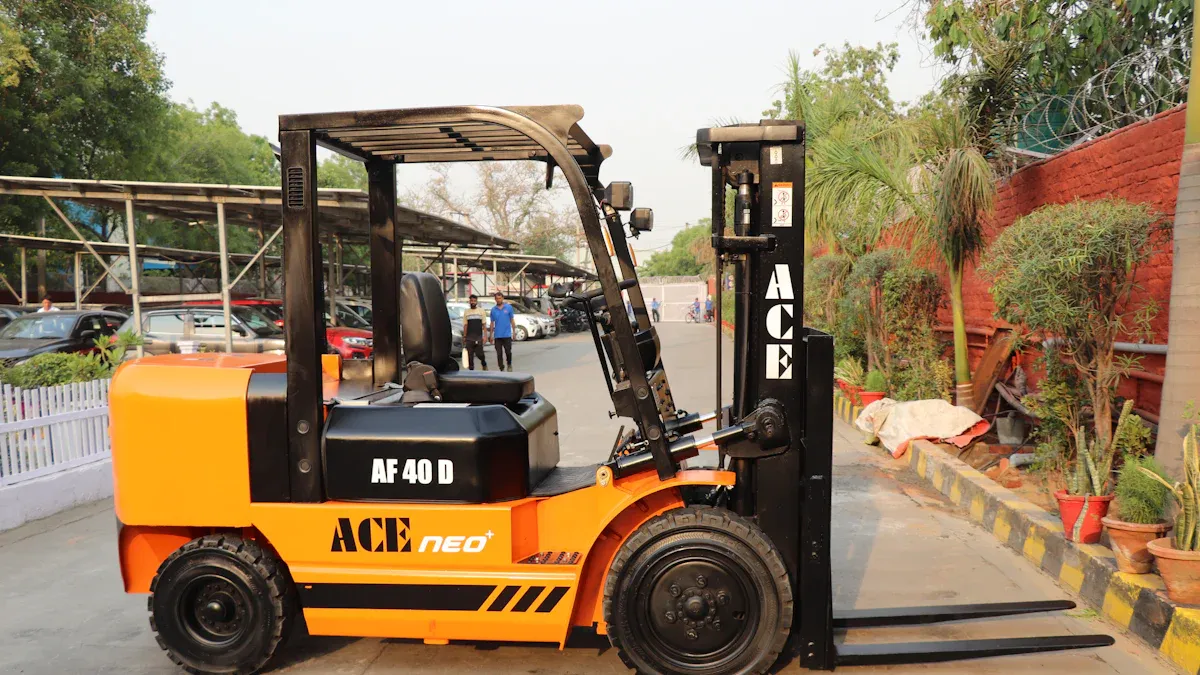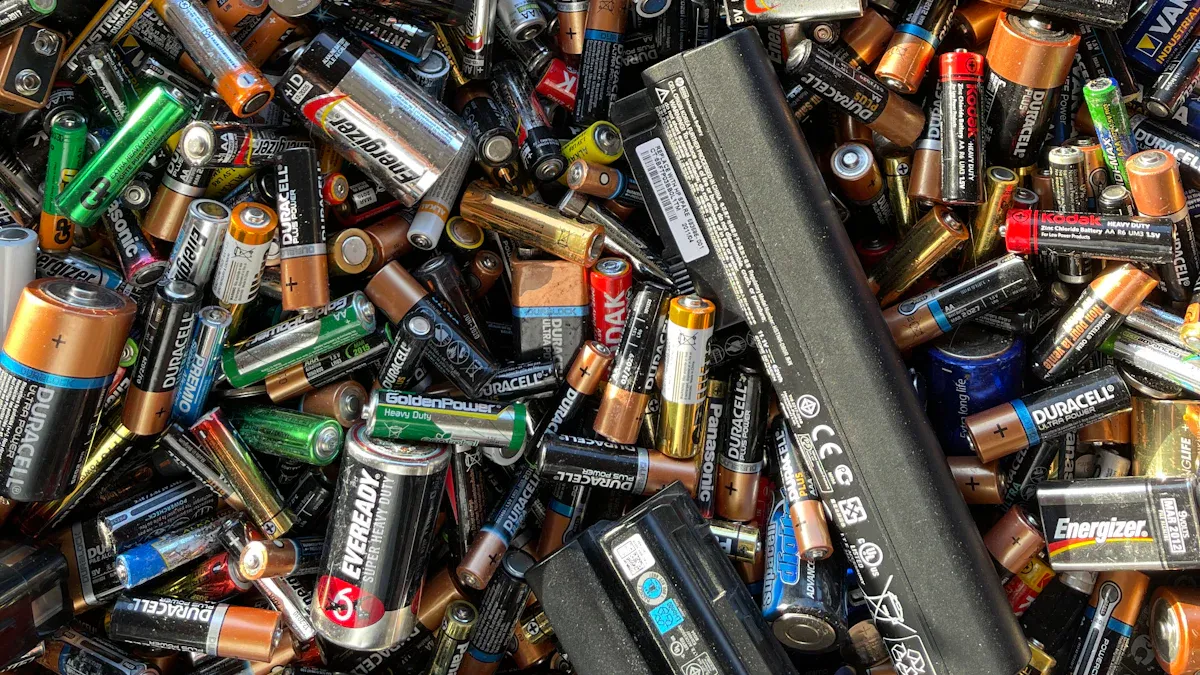September 22, 2025
Shorter Electric Forklift Battery Life

Shorter electric forklift battery life often occurs due to issues that can be prevented. Many industry surveys highlight the main reasons for this:
Excessive heat during forklift operation can quickly damage battery components.
Charging mistakes, such as overcharging or allowing the battery to deplete too much, lead to a reduced battery lifespan.
Insufficient water levels in the battery result in acid loss, which negatively impacts battery performance.
By addressing these issues, operators can extend battery life and reduce unexpected breakdowns.
Key Takeaways
Keep electric forklift batteries between 50°F and 80°F. This stops damage and helps them last longer.
Charge lead-acid batteries at 20%-40% power. Charge lithium-ion batteries when they are below 50%. This stops overcharging and sulfation.
Check battery water levels often. Clean the terminals to stop rust and keep strong connections.
Watch how you use the battery. Do not use heavy loads. This lowers stress and helps batteries last longer.
Have a regular maintenance routine. This helps find problems early and keeps batteries working well.
Shorter Electric Forklift Battery Life Causes

Image Source: pexels
High Temperatures
High temperatures make electric forklift batteries wear out faster. If batteries get too hot or cold, their parts break down quickly. Most electric forklift batteries work best from -4°F to 140°F. Some lithium-ion batteries can handle colder or hotter places, but most lose power if it is too hot or cold for a long time.
High heat can make batteries last only half as long. Inside the battery, chemical reactions happen faster. This makes the battery lose charge quickly and can cause thermal runaway.
Keeping batteries at the right temperature helps them last longer.
Best temperature for most batteries: -4°F to 140°F
Some lithium-ion batteries work from -25°F to 275°F, but they do not work well at these extremes
Heavy Usage
Using forklifts a lot puts more stress on batteries. In busy places, batteries may get charged once or more each day. Lead-acid batteries can last about 1,800 cycles. Lithium-ion batteries can last up to 5,000 cycles.
In places that run all day, a battery may be charged almost every day. Over four years, this can be more than 1,200 cycles. If you take care of the battery, it can last a long time.
Lithium-ion batteries charge in less than two hours. You can charge them during breaks to keep forklifts working.
Lead-acid batteries need about eight hours to charge. They must cool down before use. This means you may need extra batteries, which costs more and takes more time.
| Battery Type | Typical Charge Cycles | Charging Time | Downtime Risk |
|---|---|---|---|
| Lead-Acid | 1,800 | 8 hours | High |
| Lithium-Ion | 5,000 | <2 hours | Low |
Electric Forklift Batteries Charging Issues
Charging mistakes are a big reason batteries do not last long. Some people charge too often, let the battery get too low, or use the wrong charger.
Charging too much adds more cycles and shortens battery life.
Not adding water to lead-acid batteries causes them to overheat and lose acid.
Using the wrong charger can break the battery.
| Charging Type | Battery Type | Effect on Longevity |
|---|---|---|
| Opportunity Charging | Lead-Acid | Not good; can make battery life shorter. |
| Opportunity Charging | Lithium-Ion | Good; keeps forklifts running with little harm. |
| Full Charging | Lead-Acid | Best for longer life; charge fully and not too often. |
| Full Charging | Lithium-Ion | Best for most cycles and battery health. |
Operators should charge lead-acid batteries fully and not too often. For lithium-ion batteries, charging during breaks is fine and does not hurt the battery.
Poor Maintenance
Not taking care of batteries causes many problems. Checking and caring for batteries helps them last longer.
Check water every five cycles to stop acid loss and overheating.
Clean battery terminals to stop rust and keep connections strong.
Write down all maintenance to find problems early and plan repairs.
Use only distilled water to stop damage from minerals.
| Maintenance Task | Frequency |
|---|---|
| Check water levels | Every five cycles |
| Periodic maintenance inspection | At least annually |
| Battery washing and servicing | During PM inspection |
| Check battery voltages | During PM inspection |
Cleaning terminals and checking water helps batteries stay healthy and stops sudden failures.
By knowing these main causes—high temperatures, heavy use, charging mistakes, and poor care—operators can help batteries last longer. Good habits and regular checks make a big difference in battery life.
Battery Impact

Image Source: unsplash
Heat Effects
Heat changes how electric forklift batteries work. High temperatures make grid corrosion happen faster in lead-acid cells. Cold weather makes batteries weaker. Operators should keep batteries between 50°F and 77°F for best results. If batteries get too hot, they lose power fast and may break early. Forklift batteries work best when it is cooler than 113°F.
Batteries in very hot places lose power faster and do not last as long.
A steady temperature helps batteries keep their charge and work well.
Very hot weather makes grid corrosion worse.
Cold weather lowers battery power.
Best temperature: 50°F to 77°F.
Do not use batteries above 113°F.
Over and Under Charging Damages Forklift Battery Life
Charging mistakes change the inside of the battery. Charging too much makes gas push off the plates. This makes important material fall off. The battery does not last as long. Water dries up faster, and the battery gets hotter. This can be dangerous. Charging too much also causes corrosion and uses more water. This lowers battery power and can cause thermal runaway.
Charging too little causes sulfation. Sulfation makes it hard for the battery to keep a charge. It also hurts the inside of the battery.
Operators should charge batteries when they have 20% to 30% power left. Do not let batteries go below 20%. Charging in this range helps batteries last longer and work better.
Charging too much hurts plates and dries up water.
Charging too little causes sulfation and damage inside.
Charge batteries at 20%-30% power left.
Do not let batteries go below 20%.
Usage Strain
Using forklifts a lot puts stress on batteries. Charging the wrong way, like using the wrong charger, makes sulfate crystals and hurts the battery. Not doing equalization charges makes cells work unevenly and fail early. Not adding enough water dries out cells and shortens battery life.
Heavy use makes batteries work worse. Forklift screens may dim or flicker, showing less power. Sulfation builds up when water is low. This makes charging take longer and lowers cranking power. Batteries that cannot keep a charge need to be watched closely.
| Performance Decline | Description |
|---|---|
| Reduced Power Supply | Forklift screens may dim or flicker, showing weak battery power. |
| Excessive Sulfation | Sulfuric acid builds up on plates, causing less cranking power and longer charging. |
| Inability to Hold a Charge | Batteries may not keep a charge, so check charge time and levels. |
Operators who charge and care for batteries the right way see better battery power and longer battery life.
Prevention Tips
Temperature Control
Warehouse workers can help batteries last longer by keeping them at safe temperatures. Batteries work best when stored between 50°F and 80°F. Very hot or cold weather can hurt battery parts and make them work worse.
| Method | Description |
|---|---|
| Safe Temperature | Keep batteries under 113°F to help them last longer. |
| Air Circulation | Let air move around the battery to keep it cool. |
| Storage Conditions | Store batteries in a cool, dry spot away from sun and heat. |
| Charging Conditions | Open the truck and battery cover when charging. |
Charging batteries between 60°F and 100°F stops them from getting too hot. These steps help batteries work well and lower the chance of battery sulfation.
Proper Charging
A good charging plan keeps batteries working well. Workers should charge lead-acid batteries when they have 20%-40% power left. Charge lithium-ion batteries when they are below 50%.
| Best Practice | Description |
|---|---|
| State-of-Charge Level | Charge batteries at the right time for each type. |
| Opportunity Charging | Use this for lithium-ion batteries to keep forklifts running. |
| Full Charge Requirement | Always finish charging to stop battery sulfation. |
Following the maker’s rules stops overcharging and deep discharges. Charging in a clean, airy place helps protect the battery. Finishing each charge without stopping gives more usable cycles.
Maintenance Routine
Regular care stops batteries from failing early. Workers should check and clean batteries often.
Look at wires and connections for damage or rust.
Clean terminals with a wire brush and baking soda mix.
Rinse with distilled water and dry before using spray to protect terminals.
Get a pro to check batteries to find problems early.
Adding water helps batteries last longer. Workers should check water every week and only add distilled water after charging. This stops overflow and keeps the electrolyte balanced. Cleaning often removes dirt and helps stop shorts.
Usage Management
Workers can help batteries by using forklifts the right way.
| Strategy | Description |
|---|---|
| Assessing Fleet Needs | Check how forklifts are used to find heavy use or misuse. |
| Load Balancing | Keep loads even and not too heavy to stop deep discharges. |
| Shift Scheduling | Plan work so batteries can cool and recharge. |
| Battery Monitoring | Use a system to watch battery health and use. |
Every pound a forklift lifts uses battery power. Too heavy or uneven loads make the motor work harder. This causes deeper discharges and more heat. Keeping loads balanced can help batteries last up to 25% longer. With good use and care, batteries can last five to seven years or more. Good habits and regular checks help workers reach or beat this average life.
Shorter electric forklift battery life can happen because of heat, wrong charging, or bad care. Operators can stop batteries from wearing out fast by using these smart steps:
Teach workers how to charge batteries safely and use new charging stations with auto-shutoff.
Make a charging plan and check batteries often for damage or leaks.
Look at electrolyte and water levels, clean battery terminals, and do not use forklifts if batteries have less than 20% power.
| Maintenance Practice | Impact on Battery Longevity |
|---|---|
| Regular Watering | Stops sulfation and keeps batteries safe |
| Full Charges Only | Helps batteries stay strong and last |
| Monthly Cleaning | Lowers the chance of leaks and rust |
Checking and caring for batteries often helps them last longer. Operators should use these ideas to keep batteries working well and dependable.
FAQ
How long does an electric forklift battery usually last?
Most electric forklift batteries work for five to seven years. Taking care of batteries and charging them right helps them last longer.
What signs show a forklift battery needs replacement?
Operators see batteries charge slowly or run out fast. Forklift screens may look dim. These signs mean the battery cannot keep a charge and might need to be replaced.
Can high temperatures damage forklift batteries?
High temperatures make chemical reactions happen faster inside batteries. This makes batteries wear out sooner and can cause safety problems.
How often should operators check battery water levels?
Operators should look at water levels once a week. Checking often stops acid loss and keeps batteries from getting too hot.
Tip: Always use distilled water when caring for batteries. This stops minerals from building up.













 English
English 


